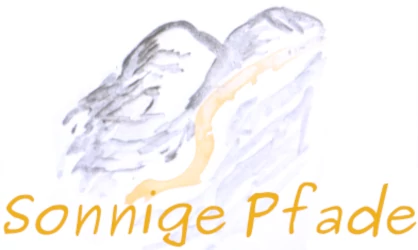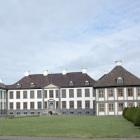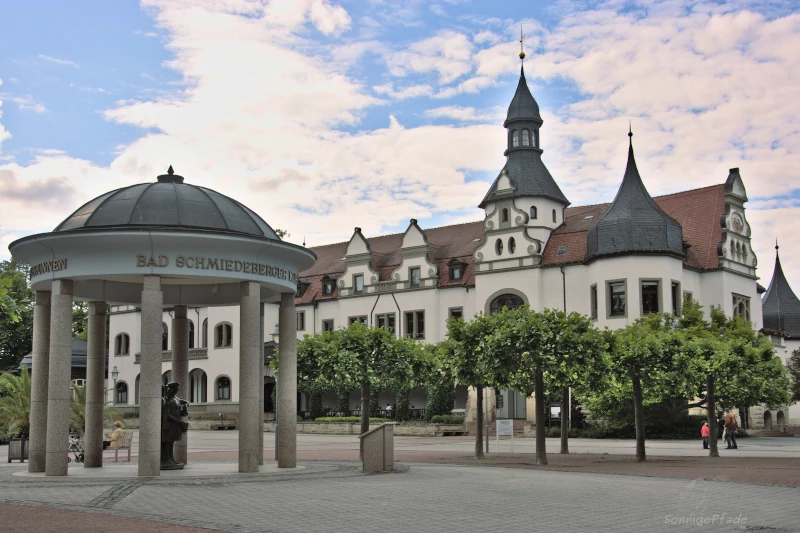
The two larger towns in the Dübener Heide (Dueben heath) in east germany include Bad Düben in the north of Saxony and Bad Schmiedeberg on the Anhalt side. The addition „Bad“ in german for a town name means official a district with health resort, sanatorium area or spa place. Bad Schmiedeberg is located on the eastern edge of the Dübener Heide about 10km from the Elbe river. If you want to explore the Dübener Heide by hiking, you can get a first impression between the two spa towns via various hiking trails. The large stream of visitors in Bad Schmiedeberg, however, is mainly due to the spa guests in the iron moor bath.
Historical small town center and spa town Schmiedeberg
Bad Schmiedeberg is located about 30km south of the county seat Wittenberg (Luther’s place, starting point of the christian church reformation) in the state of Saxony – Anhalt, west of the Elbe River. The small town is largely surrounded by the forests of the Dübener Heide, to the east also by fields.
Away from the main traffic lines, Bad Schmiedeberg is actually only visited by those who live there or are looking for peace and quiet from the hustle and bustle of everyday life. So it is quite fitting that the surroundings of Bad Schmiedeberg are characterized by the Dübener Heide Nature Park. To the west of the town, hikes are possible in the extensive forests. To the east, nature lovers will also find larger water areas at the Lausig Ponds with a camping site and bathing area. A large area to the west and south of the Lausig Ponds natural pool is a nature reserve.
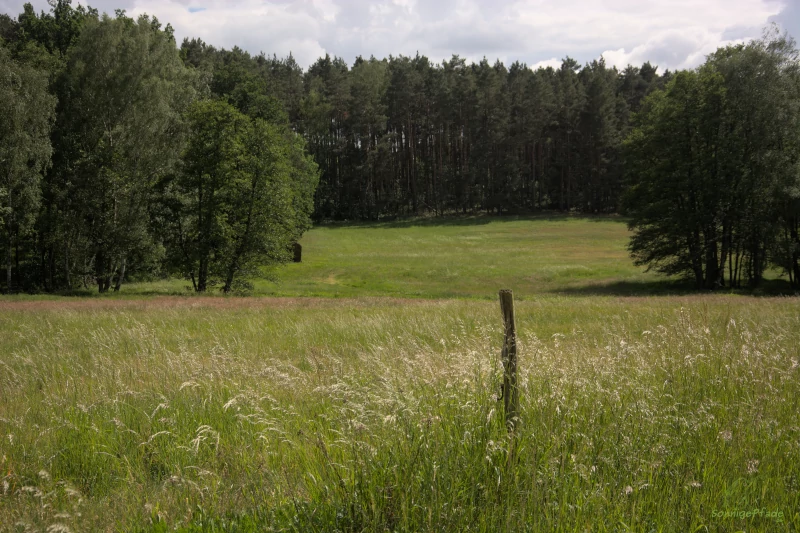
Traces of the past in the town center
The first known mention of Schmiedeberg dates back to 1206 as a place called „Smedeberg“. Schmiedeberg received its town charter in 1350. The year 1429 was decisive, when Schmiedeberg was burned down by the Hussites. There are practically no buildings or other traces from the time before. During the reconstruction Schmiedeberg got solid town walls and two town gates. The Au Gate, which to this day provides access to the town center from the north, was named in writings as early as 1490. The striking town church of St. Nikolai with its tower visible from afar was built in 1454 in late Gothic style. It received a new organ with romantic sound characteristics in 1853.
Also worth seeing is the town hall from 1570 in Renaissance style, which dominates the Schmiedeberg market. On the square in front of it there is a monument to the fallen of the German-French war of 1870/71 in the form of a narrow, pointed pyramid column.
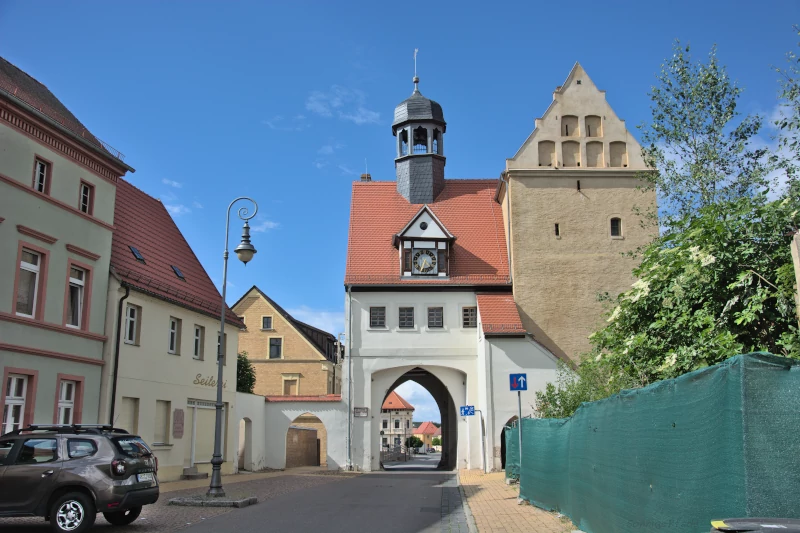
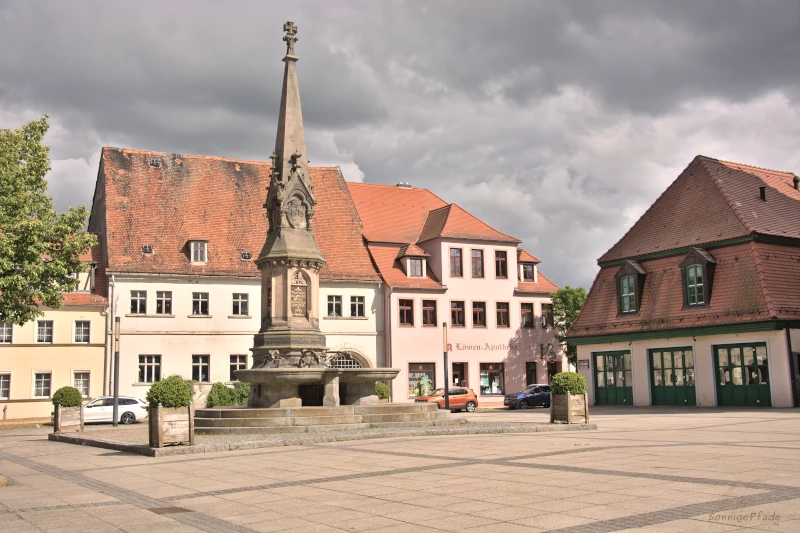
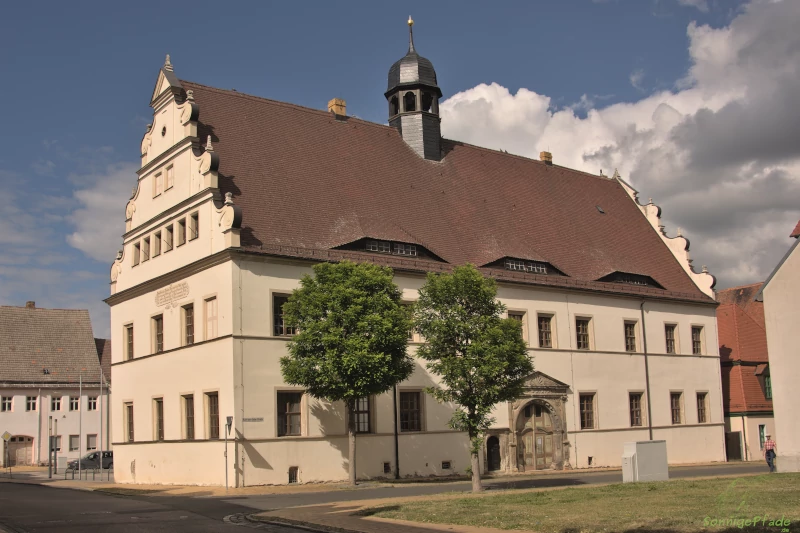
The ensemble of old town houses in downtown Bad Schmiedeberg is also otherwise worth seeing.
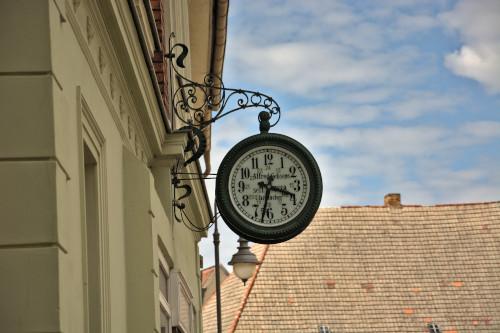
Some richly decorated gateways and doors, the narrow streets, symbols of old crafts and smaller squares make a tour of Bad Schmiedeberg quite varied.
Unfortunately, my experience when visiting on a sunny Sunday afternoon was rather typical for many of today’s (East?-) German small towns – I was largely alone in empty streets, only now and then a car passed by, no walkers, no cyclists far and wide except for me.

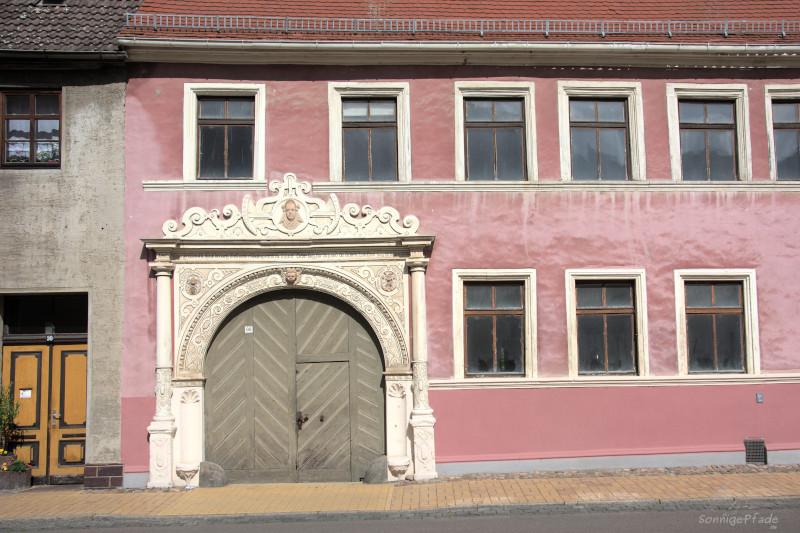
Bad Schmiedeberg spa center and spa park
This impression of empty streets changed abruptly when I paid a visit to the spa area: There, the square and the spa park were busy, guests were sitting in cafes and in front of ice cream stores, the benches around a small pond were well occupied. It’s a real pity that the obviously well-received spa has so little impact on the „rest“ of the town!
Iron moor bath with tradition
In 1878, a municipal iron moor bath was established in Schmiedeberg. This facility obviously developed well, because in 1925 Schmiedeberg received official recognition as a „spa“ (in german „Bad“).
As early as 1908, a spa house was built, based on designs by Leipzig architect Arthur Hänsch. The spa house and a water tower nearby are fine examples of Art Nouveau architecture. To this day, the Art Nouveau – Kurhaus attracts guests of Bad Schmiedeberg for information on spa treatments as well as events ranging from readings to concerts.
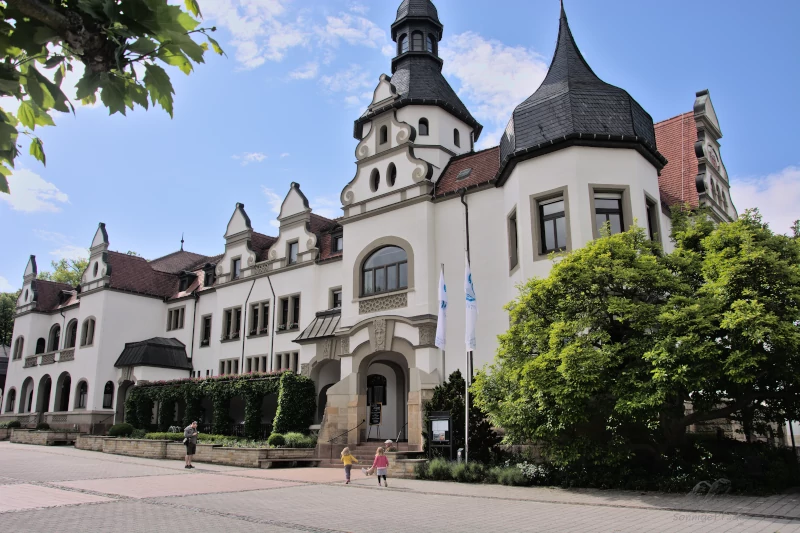
Opposite the spa house on the edge of the spa park with the pond stands a stone round pavilion, which contains two bubbling springs – he Elector’s Well and the Margaret Well. One figure each – a male and a female, perhaps the „Elector“ and „Margaret“, standing back to back, let their healing waters run from the pitcher into a bowl. Those who like can fill a cup or bottle with their share of the rippling stream and let the healthy powers take effect.
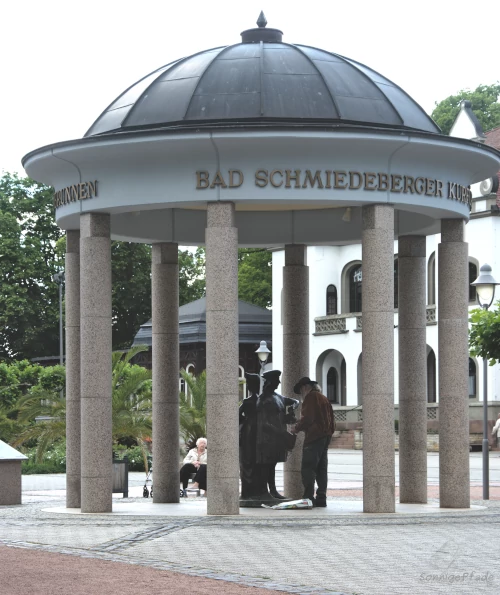
Healing fountain and „sea breeze“ from the graduation work
Boards next to the well temple inform about the composition and effect of the waters. The Margaret Well supplies fluoride water from a depth of 134 meters. The healing effect refers to functional stomach disorders, relief of kidney ailments and caries prophylaxis. Water for the Elector’s Well in Bad Schmiedeberg is extracted at a depth of 215m. The Elector provides fluoride-containing sodium – hydrogen carbonate – sulphate water and additionally supports the treatment of osteoporosis. This source is used gladly, above all naturally on sunny – hot days. I have also filled up my bicycle bottle.
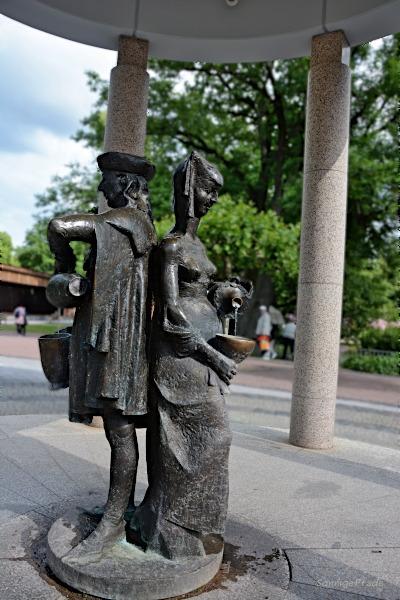
A few meters further stands a still quite new „mini – graduation work“. With just 31m length and a good 5m height, the new graduation work in Bad Schmiedeberg is already a „living room – version“ compared to those, for example, in Bad Kösen, which reaches the height of a multi-storey house.

But the desired effect is certainly noticeable in Bad Schmiedeberg: a steady flow of a brine trickles over the sloe twigs, which are closely layered in the wooden frame – salty water is deflected by the fine branches and twigs and broken up into smaller and smaller droplets, thus trickling slowly downwards. This creates a fine mist of the salt water, which enriches the air in the immediate vicinity of the graduation house. When you walk around the graduation work, you breathe in this salt-moist air, which has an excellent healing effect on the respiratory tract and lungs – similar to a stay at a seaside resort on the Baltic Sea. This mist can also have positive effects on skin diseases.
The spa clinic in Bad Schmiedeberg is mainly focused on patients with orthopedic and gynecological ailments.
In the spa park there is a „federal cyclist monument“. This is not dedicated to the victims of traffic on German roads, but was inaugurated as early as 1923 with the participation of several thousand cyclists. The idea was to commemorate not only German national patriotism and culture in cycling clubs, but also the fallen of the First World War.
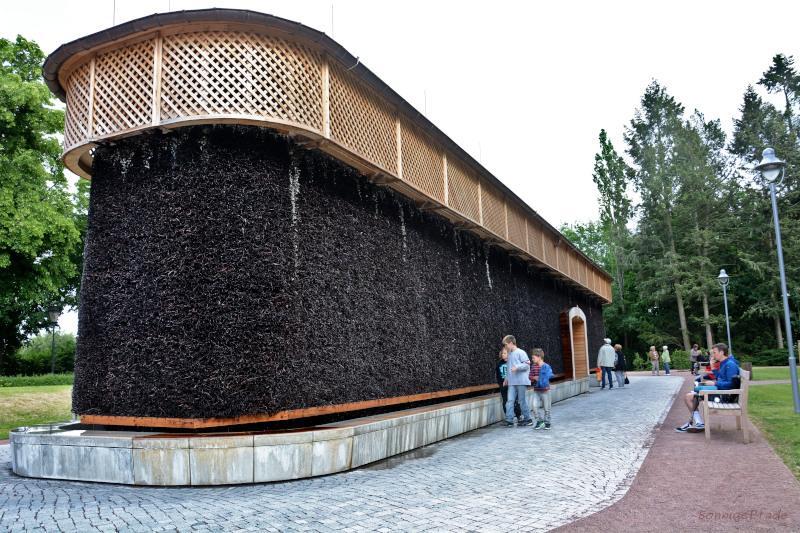
Other sights in the vicinity of Bad Schmiedeberg
I have already mentioned the possibilities for hiking in the Heathland of the Dübener Heide. I was on the way with the bicycle between Oranienbaum and the Elbe cycleway near Pretzsch. However, my impression was that the northern part of the Düben Heath in Saxony Anhalt is more difficult by bike, because the forest roads are often very sandy and therefore exhausting to ride. Several times I even had to push. In the Saxon part in the vicinity of Bad Düben, the forest roads have been expanded in many places, using as material coarse chippings and more clayey binder, which makes the surface of the paths much firmer and more „rollable“.
A sight about 5km from Bad Schmiedeberg I missed smoothly – the castle Reinharz. Once in the swing of a downhill wrong turn, I was completely on another route. I’ll have to make up for that later. Castle Reinharz is considered an interesting water castle – facility and sight in the vicinity of Bad Schmiedeberg.
In the city forest also on foot to reach is the Kaiser Wilhelm – tower of 1910 with restaurant „Schöne Aussicht“ (nice view). With it you can enjoy the view from 208 m above sea level and have a destination for a forest hike. The shortest distance from the spa is about 3.5km for pedestrians.
Already in 1993, three years after annexation of east germany, „the west“ arrived in Bad Schmiedeberg: with a new leisure and adventure pool „Basso“ on the outskirts of the town. At that time, this first large new bathing facility was popular in a wide area and was one of the new recreational pleasures that had not previously existed in eastern Germany. Since 2003, the „Basso“ has been closed, massively destroyed by scrap metal thefts and vandalism, and today already partially reclaimed by nature (i.e. – overgrown). A ruin of prosperity, which is considered one of the most famous recent „lost places“ in Germany. Photos of the „Basso“ ruin are circulating in all kinds of forums and media dealing with the phenomenon of lost places.
[Contains *advertising]
Travel tips for Bad Schmiedeberg
Arrival
By public bus from Wittenberg train station
The journey to Bad Schmiedeberg is possible by bus from the train station (ICE – stop*) of the district town Lutherstadt Wittenberg. There is a bus from Wittenberg via Kemberg to Bad Schmiedeberg on line 306 or via Pretzsch on line 333.
Buses also run from Gräfenhainichen (regional train station) to Bad Schmiedeberg on line 331.
Updated timetables in the district of Wittenberg, including any temporary changes, can be viewed on the website of Bus service Vetter.
Outside of regular bus times, call buses operate in the district of Wittenberg. These can be ordered by calling 0800 0366910 from Monday to Saturday 6-20 at least 1 hour before departure.
Actually, Bad Schmiedeberg is also located on the railroad line Eilenburg – Bad Düben – Bad Schmiedeberg – Pretzsch – Lutherstadt Wittenberg. But this is now only occasionally served on weekends for tourist excursions, and according to my research, since the Corona – lull no traffic has taken place again. For a long time, this Heidebahn (Heathlandtrain) was considered a pillar for tourism in the Dübener Heide. Then first the state of Saxony cancelled the traffic on its side of the heath and later also Saxony – Anhalt, which could not carry the traffic on the branch line to Bad Schmiedeberg alone. Maybe the Heidebahn will be revived in the future with the return to local destinations.
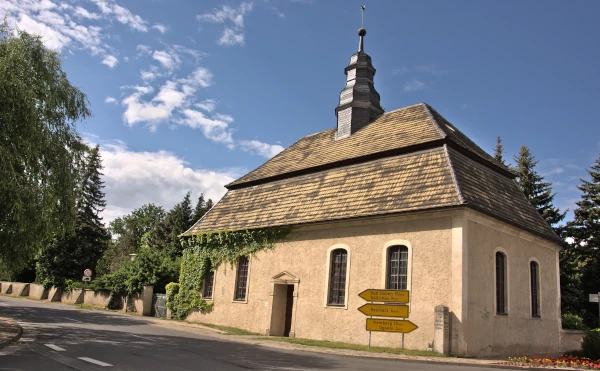
By car
Next airport to Bad Schmiedeberg is Leipzig – Halle airport (LEJ). There you can get full service with rental car station or public transport.
If you are traveling by car or rental car*, you can arrive from the north via Wittenberg on the B2 and then have to choose one of the country roads, e.g. from Kemberg. From the south, you can also take the B2 from Leipzig to Bad Düben and then follow the country road for about 15 km to Bad Schmiedeberg.
The eastern route is via the B 182 along the Elbe to Pretzsch (from the north) or the turn-off shortly after Greudnitz at the Saxon state border (from the south).
Those arriving by motor home* will find natural caravan sites, especially at the campground at the Lausiger Teiche (Lausig ponds) east of Bad Schmiedeberg.
By bike via Mulde or Elbe cycle path
By bike, one of the connections is Leipzig (or Mulde river cycle way) – Bad Düben – Bad Schmiedeberg as a designated cycling route. The other alternative is the Elbe cycle path to the height of Pretzsch and from there a little west to Bad Schmiedeberg, with one of the routes passing between Pretzsch and Bad Schmiedeberg. A ferry also crosses the Elbe in Pretzsch.
Accommodation in Bad Schmiedeberg – hotel and apartments
Spa hotel Bad Schmiedeberg
There is one ***spa hotel* in Bad Schmiedeberg that has average good ratings. This is located right near the spa area, making it ideal for spa guests visiting for several days. Breakfast is served at the buffet. Bicycles can be safely stored in the house. Parking at the house free of charge.
Vacation apartments in the surrounding area
All other accommodations are vacation homes and apartments in the immediate vicinity of Bad Schmiedeberg, some in idyllic locations in the Düben Heath.
The Pension an den Weinbergen* is a vacation apartment in a bungalow with space for 3 guests in two bedrooms (expandable with sofa bed if necessary). A well-equipped kitchen is available in the house. The garden at the vacation apartment attracts to relax, it is also possible to have a barbecue.
Accommodation for up to 6 guests is offered by the Waldhaus Eichhörnchen*, a vacation home directly on the edge of the forest near Bad Schmiedeberg with direct access to hiking trails. However, the spa park and the spa center are also not too far from the wooden house. Three bedrooms, two bathrooms, living area and garden with barbecue facilities make the stay in the vacation home Waldhaus Eichhörnchen a relaxing vacation. Even a sauna is available. The kitchen makes self-catering well possible. For families with children, books, DVDs and board games are available. Several restaurants 1 to 2km away make it possible to skip cooking for a change and combine meals with digestive walks through the heath.
About 7km from Bad Schmiedeberg, the Gästehaus zur Bienerei* (Guest house to the bees) welcomes visitors in the village of Trebitz (located on the B182). Up to 5 guests will find their night’s lodging in the vacation house in three bedrooms, among them surely many cyclists from the Elbe cycle path. A small kitchen for self-catering is in the house, there is a private baker in the village. Honey can be bought directly from the beekeeper. A terrace with garden furniture and barbecue are available to guests of the vacation home. Good to reach from Trebitz is also the Lutherstadt Wittenberg.
Extend the short trip? Visit Oranienbaum and Wörlitz!
Small tour to Bad Schmiedeberg? Of course with friends!
If you liked the post about Bad Schmiedeberg and it was helpful for your travel plans, please share the link to the post on your social media channels. A positive response on social media helps search engines separate good posts from data garbage and improves search results for everyone. Thank you!
Note on * advertising links
Some links in the post are marked with *. These are advertising links that lead to online – stores or agencies. If you buy or order something there, the sonnige pfade blog receives a small commission to cover the technical expenses. Nothing will be more expensive for you, because the commission is already calculated by the providers in the pricing.
